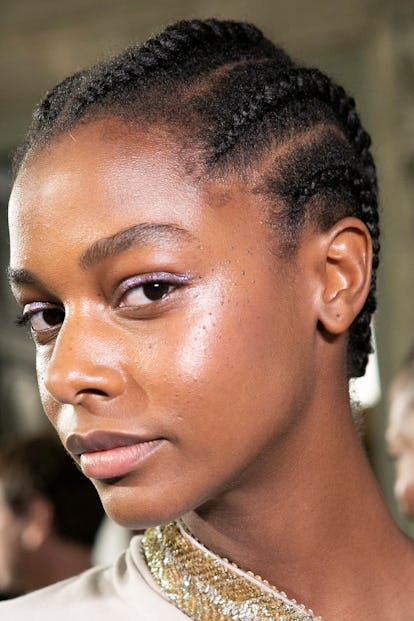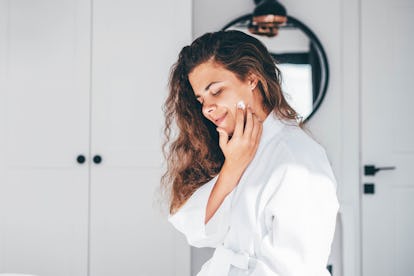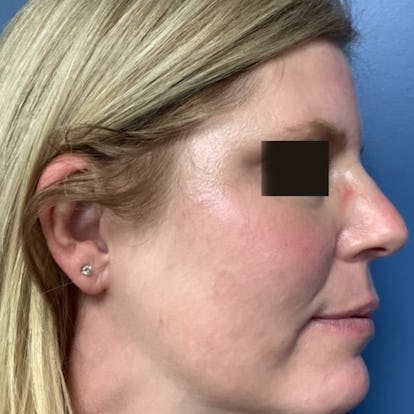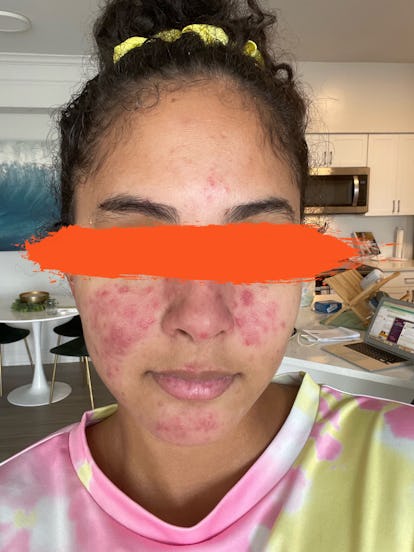Experts weigh in on why not washing can work for you.
I wish I could say that my chronically flaky scalp is my secret shame — but sadly, it’s not much of a secret. With dark brunette roots as its backdrop, my dandruff shines; set against an all-black wardrobe, the flakes positively pop. Well, make that “popped.” Ever since I stopped washing my hair, my head has been nearly flake-free. I’m not exaggerating. My "no-poo" routine has actually turned out to be the best dandruff treatment I’ve ever tried, and I’ve tried them all.
I got the idea from my face. After learning about how over-cleansing can lead to a terrifying combination of dehydrated skin and increased oil production, I phased out my face wash. A week of splashing with water later, my complexion was 75% clearer. Hmm, I thought. Could over-cleansing be the culprit for my simultaneously flaky and oily scalp, then?
Yes, and it even has a name. “We call that being ‘trapped in the cycle,’ and the concept is often misunderstood,” Jackie De Jesu, a hair expert and the founder of Shhhowercap, tells The Zoe Report. “If you over-wash your hair, then it strips your scalp of its natural oils.” Without sufficient oil, the scalp becomes dehydrated and potentially flaky.
“This imbalance creates the illusion of oily hair, because your scalp’s [oil production] is thrown into overdrive to compensate,” De Jesu adds. Then the cycle starts: You assume you need to shampoo away the extra oil, which makes the scalp even drier, which leads it to produce more oil to make up for the fact that it’s so darn dry. “In fact, if you stopped shampooing so frequently, then your scalp would level out and be less oily,” she says. And, in my case at least, less flaky.

Before enacting my shampoo ban, I washed my hair pretty much every day. I know, I know, that’s a lot — but I have thick curls and bad bedhead, and felt like I needed a fresh wash for my hair to look best. According to De Jesu, I was actually sabotaging my strands. “It’s unnatural for our bodies to be washing our hair so frequently,” she says, and that can lead to “increased breakage, dryness, dull color, and frizz,” as well as the aforementioned dry-meets-oily scalp situation.
As soon as I stretched out my wash days — first to every other day, then to twice a week, then to almost never — my hair bounced back, quite literally. Not only is my dandruff gone, but my curls look healthy and springy, no matter how long it’s been since my last shampoo. (It took about two weeks for my scalp to adjust and not produce so much extra oil, by the way. Headbands are your friend in the transition phase.)
Lorraine Massey, hair stylist and creator of the Curly Girl Method, isn’t surprised by my results. “Sulfate shampoo is a basic detergent, and creates the same lather, suds, and bubbles found in dishwashing and clothing detergents,” she tells TZR, referring to sodium lauryl sulfate, or S.L.S., a common ingredient in most mainstream shampoos. “When we over-wash our natural, organic hair fiber, it begins to wear out like any article of clothing would if we washed and wore it every day of our lives.” (Mind = blown.)
To get a sense of how, exactly, this works, Massey suggests a fun little exercise: Put a drop of shampoo on a sponge, add water, and rinse it out. “Notice how much water it takes to rinse out the small droplet of shampoo — it takes gallons and yet it still holds on to the frothy stuff,” she says — and your hair does, too. “The soap holds on to the residue, leaving behind salty deposits from the sodium that settle on the scalp, creating dry, itchy, and dandruff-like flakiness.”
So, how often should you be shampooing for optimal scalp and hair health? “NEVER,” writes Massey in an email, emphasis hers. “It is truly possible to forgo shampoo completely.” She’s been shampoo-free for an impressive three decades and counting, and says the secret is using just one product that can cleanse and condition. This is often called “co-washing,” or the “no-poo” method, and it works for all hair types. “For example, CurlyWorld’s ShamFree is a scalp and hair cleansing and conditioning detangler, all mixed into one," Massey says.

If you’re not ready to commit to the no-poo life, that’s fine. You can theoretically get similar results from significantly scaling back on shampoo — say, using a sulfate-free version once a week instead of three times a week. “I went from washing my hair every other day to now washing it once every five to seven days,” De Jesu says. “My personal journey has brought benefits like additional shine and thickness. My hair also grows notably faster.” On “off” days, De Jesu keeps her hair dry by wearing a Shhhowercap in the shower. I do the same; although I do often wet my hair in the shower without shampooing, just to refresh my curls a bit.
Afterward, I comb and spritz with a leave-in conditioner. Oh, yeah, I’ve effectively given up on traditional conditioner, too — but that’s another story.
I've been dealing with rosacea for years. Back then, I mistook my chronic redness and bumpy skin for standard sensitivity and breakouts. In reality, though, I was experiencing mild rosacea flare-ups. It wasn’t until later, when I received a diagnosis from multiple skin experts, that I realized what my symptoms really were and started treating them accordingly. Even now, so many years later, I struggle with occasional flare-ups.
I’m certainly not alone in my struggle with rosacea. According to the American Academy of Dermatology, more than 14 million people have this condition in the United States alone. And even though experts are still unsure of the exact cause, there are many well-known triggers and treatments.
But first, what exactly is the rosacea? According to Dr. Corey L. Hartman, board-certified dermatologist and founder of Skin Wellness Dermatology in Birmingham, Alabama, “Rosacea is a chronic, inflammatory skin condition characterized by central facial redness, papules and pustules, flushing, red eyes, and a feeling of warmth in the skin. There are four main subtypes that are all thought to be mediated by neural control of the small blood vessels of the face.”
Dr. Geeta Yadav, board-certified dermatologist and founder of Skin Science Dermatology, says that this chronic inflammatory condition tends to manifest with “dry, sensitive, and painful skin,” which is why it’s essential to consult a dermatologist if you think you have it. There’s no room for self-diagnosis with rosacea, especially since not all facial redness is rosacea. “For example, someone with redness could have lupus or eczema,” Yadav explains. Nor does rosacea present the same on every skin tone. For more melanated skin Dr Alia Ahmed, dermatologist at GetHarley, adds that, “skin can also feel 'swollen' or 'thick' and it may differ in texture from unaffected areas as well as skin-colored or yellow/brown bumps.”
Says Dr. Loretta Ciraldo MD FAAD, a Miami-based board-certified dermatologist and founder of Dr. Loretta skin care, “I have seen many patients who came to me with facial redness, often self-diagnosed as rosacea, when they actually had other easily treatable diagnoses including sensitivity to irritating facial products, sun allergy, and steroid acne.”

What Are The Symptoms Of Rosacea?
A common misconception is that rosacea is just redness. In reality, rosacea often involves a whole host of other symptoms, including papules and pustules (raised bumps and breakouts), broken blood vessels, and dryness and irritation. “When assessing a patient’s skin to determine if they have rosacea, one of the first things dermatologists look for is the distribution of the redness (nose, cheeks, and chin), the presence of papules and pustules, as well as telangiectasias (broken blood vessels),” Dr. Yadav says. Dry eyes are also a common symptom of the condition.
What Causes Rosacea?
While experts are unsure of the exact cause of rosacea, they do know that it could be associated with genetics, environmental factors, and/or an overactive immune system. As for the latter, it comes down to microorganisms that live on the surface of the skin and how the body interacts with them. “Living microorganisms on the skin are recognized as foreign by the body’s immune system,” explains Dr. Dendy Engelman, board-certified dermatologist and cosmetic surgeon at Shafer Clinic Fifth Avenue. “The immune system springs into action to counter this potential threat resulting in the inflammation, redness, or bumps.”
However, there are well-known and widely-recognized triggers for flare-ups. “Rosacea has many triggers,” Dr. Engelman says, “such as sun exposure, extreme temperatures, stress, alcohol, spicy foods, and certain [product] ingredients.”
Dr. Hartman agrees, saying that certain foods (specifically red wine, cheese, and seafood) and hot drinks (especially coffee and tea) can cause a reaction. “Rosacea treatment is really about management and being aware of what triggers flare-ups and avoiding those things,” he says.
The biggest trigger, though, is often stress (yes, really). “Because rosacea is an inflammatory skin condition, one of the greatest triggers is stress,” Dr. Yadav tells TZR. “Stress and anxiety, especially chronic cases, can exacerbate rosacea.”

How Can You Manage Rosacea Flare-Ups?
“Chronic” is the keyword when it comes to rosacea, as it can’t be cured, only managed. “Its symptoms can be managed and reduced by adhering to certain lifestyle changes and using the right products,” Dr. Hartman says. However, as I know all too well, flare-ups happen. When they do, the experts have some recommendations for how to calm and soothe the skin.
1. Apply Sunscreen & Moisturizer Every Day
For Hartman, it’s all about moisture and sunscreen. “A gentle, hydrating moisturizer and sunscreen will be your best friend,” he says. “You want to keep your skin moisturized and protected from the sun’s rays at all times.”
Dr. Engelman agrees. “Moisturize often! I also suggest showering in cool water as hot water can draw out moisture from the skin.” She adds that a tinted moisturizer and SPF will help neutralize the appearance of redness and minimize flares from UV exposure. “I also suggest patting instead of rubbing on your makeup as friction can increase the redness,” she says.
2. Use & Avoid Specific Ingredients
“Patients with rosacea truly have sensitive skin,” Dr. Hartman says. “While many people falsely think that a reaction to one product deems them sensitive, those with rosacea are intolerant to many active ingredients in skin care products that prove beneficial for others like retinol and salicylic acid.” As such, he cautions against using any ingredients known for causing dryness or irritation, including alcohol, witch hazel, menthol, fragrances, propylene glycol, and sodium laurel sulfate.
As for which ingredients you should use, look for products that contain niacinamide. “Niacinamide can help soothe inflammation and reduce redness, as does vitamin C,” Dr. Hartman says. “It’s ideal to introduce a new product to your skin care routine when you are not having a rosacea flare-up to ensure you won’t have a reaction. And do a patch test first before putting it all over your skin.”
Dr. Engelman also suggests implementing products that contain skin barrier-building ingredients, like peptides, ceramides, and hyaluronic acid. “These are known to be gentler on the skin while helping retain moisture,” she says.
3. Stay Out Of The Sun & Heat
Although it can be tough in the summer, “staying hydrated, calm, and cool will go a long way towards improving the appearance of your skin during a flare-up,” Dr. Yadav says. “Seek out gentle, fragrance-free moisturizers, drink plenty of water, and avoid overly hot showers so as not to strip your skin of its natural oils. If you’re someone who loves baking in the sun or steaming in a sauna, it’s time to switch things up — those practices can trigger your rosacea.”
Dr. Ciraldo agrees, noting that the best thing you can do during a flare-up is to avoid excess sun exposure. “There is mounting evidence that visible/blue/HEV light can cause redness in the skin,” she adds. And since our exposure to this spectrum of light doesn’t change much throughout the year (including in the winter), it’s critical that you wear sunscreen every single day. Dr. Ciraldo recommends using one that protects from UVA, UVB, and HEV light.
4. Follow A “Rosacea Diet”
During a flare-up, Dr. Ciraldo recommends following a “rosacea diet,” in which you eliminate spicy foods, hot drinks, and alcohol for at least two weeks. Since these foods and drinks are common triggers, eliminating them can soothe the skin and reduce the severity and longevity of a flare-up.
5. Manage Stress Levels
I know this one is easier said than done (trust me), however, it can make a big difference in the state of your skin, seeing as stress is such a significant trigger. It might mean committing to some self-care. “Practice calming self-care rituals, such as yoga, meditation, or taking lukewarm baths,” Dr. Yadav suggests.
A critical component of self-care and stress management is simply getting enough quality sleep each and every night. As Dr. Ciraldo puts it, “lack of sleep causes stress to our system,” which can worsen rosacea symptoms. As if you needed another reason to focus on your sleep...

Are There Professional Treatments For Rosacea?
“For patients with more severe rosacea, there are topical and oral medications that we can use to manage the condition, as well as some in-office procedures that target blood vessels,” Dr. Hartman says. In other words, it pays to see a dermatologist to explore all possible treatment options.
Topical Prescriptions For Rosacea
For Dr. Engelman, Rhofade is her go-to prescription. It’s the only cream of its kind that's approved to treat persistent facial redness. “Rhofade (oxymetazoline hydrochloride) cream, 1%, is FDA-approved for the topical treatment of persistent facial erythema (redness) associated with rosacea in adults,” she says, adding that “if all other options have been exhausted, laser treatments are very effective at minimizing persistent facial redness. Lumenis Stellar M22™ is a great option that uses IPL (Intense Pulsed Light) technology. It helps alleviate the inflammation, redness, pimples, and uneven skin tones caused by the condition.
In-Office Treatments For Rosacea
As for Dr. Hartman, he recommends two different in-office procedures. The first is Sciton’s Broad Band Light (BBL) and the second is Cutera’s Excel V. “Sciton’s Broad Band Light (BBL) treats red and brown discoloration on the skin with no anesthesia required. It’s like a magic eraser for sun damage that gently flakes for a day or two following the procedure. Patients enjoy the results after a series of three monthly treatments and then continue with a treatment every quarter or so for maintenance. BBL is one of the few true preventative treatments to keep the rosacea redness in check.”
For more stubborn blood vessels that become permanent from years of rosacea flushing, he recommends Cutera’s Excel V. “The chronic dilation of the vessels cause the muscles in the vessel walls to become weak and stuck in the ‘on position,’” he explains. “At that point, topicals aren’t effective and laser treatment is necessary to zap the vessels. This device delivers great results in three treatments with virtually no downtime and little discomfort.”
What About OTC Rosacea Skin Care Products?
Dr. Hartman recommends a basic routine for patients with rosacea that involves a gentle, hydrating cleanser, a serum that can help even texture and reduce redness, moisturizer, and, of course, broad-spectrum sunscreen to protect against UV light.
Below, see eight expert-recommended products for the long-term management of rosacea.
We may receive a portion of sales if you purchase a product through a link in this article.
